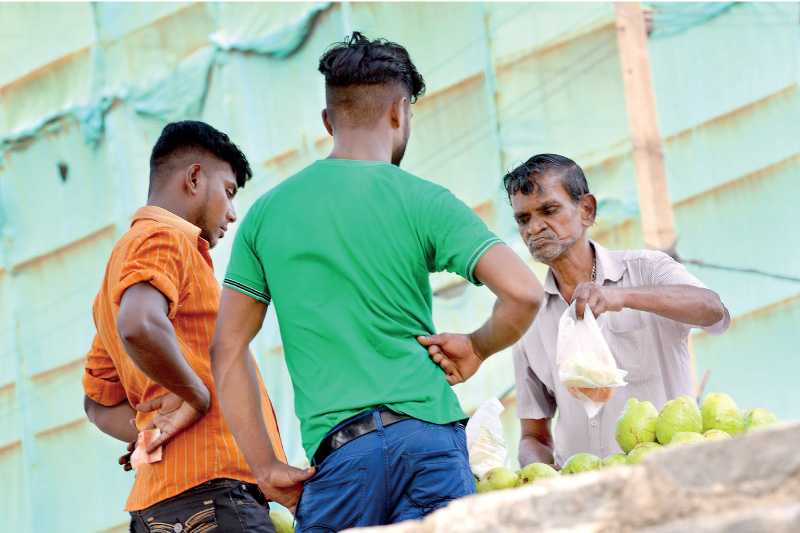Monday Feb 24, 2025
Monday Feb 24, 2025
Monday, 22 March 2021 00:26 - - {{hitsCtrl.values.hits}}

The young man on the motorbike visits the borrower daily and does not leave any room for him to default the loan. Banks cannot relax their systems to such an easy and loose credit appraisal and recovery tactic – Pic by Shehan Gunasekara
 In the previous part, we looked at how the late K. Sivagananathan, known to his friends as Siva, contributed to developing banking education and introducing modern technology to the country’s payments system. It was noted that Siva played a key role in getting the qualifications of the Institute of Bankers of Sri Lanka or IBSL accredited by UK’s Institute of Financial Services or IFS, formerly known as the Chartered Institute of Bankers, UK. This paved way for students following courses at IBSL to get international recognition.
In the previous part, we looked at how the late K. Sivagananathan, known to his friends as Siva, contributed to developing banking education and introducing modern technology to the country’s payments system. It was noted that Siva played a key role in getting the qualifications of the Institute of Bankers of Sri Lanka or IBSL accredited by UK’s Institute of Financial Services or IFS, formerly known as the Chartered Institute of Bankers, UK. This paved way for students following courses at IBSL to get international recognition.
In the payments sector, he was one of the main contributors to the creation of LankaClear for cheque clearing and offering payments services in Sri Lanka. This was a public private partnership in which the Central Bank teamed with commercial banks to upgrade the service package of its Automated Clearing House or ACH on modern lines. In this respect, Siva was a trailblazer in Sri Lanka’s banking sector.
In today’s part, we look at how the banking sector should support the COVID-19 pandemic hit small business sector in the country.
COVID-19 pandemic hit economy
By any standard, the COVID-19 pandemic was an external shock delivered to the global economy disrupting all economic activities. The safe health measures introduced, and the prolonged lockdowns of economies have pushed the global economic growth to the negative region. In the case of Sri Lanka, 2020 has been a write-off year with respect to economic growth. The best estimates made by ADB and the World Bank indicate that the economy may have contracted by about 6% in 2020.
Though the authorities are hopeful that there would be a quick recovery in 2021, with the onset of a more disastrous second wave and possibly a third wave later, it would be a prolonged W-shaped recovery that Sri Lanka might at best be able to attain. What this indicates is that economic growth will be either negative or very low in the next few years. The best-case scenario, as predicted by the Central Bank in its Recent Economic Development Report issued in November 2020, is that the economy will revert to the normal growth path – at about 7% per annum – not earlier than 2025.
 Banks being called to take the full burden of revival
Banks being called to take the full burden of revival
A powerful section in society including the top policy leaders appears to be in the belief that it is the banking sector that should take the full brunt of the recovery of the economy in the post-COVID-19 pandemic era. This was an erroneous suggestion since banks had only one nominal weapon, namely enhancing credit flows, whereas the recovery of the economy depended on stimulating the country’s real economic flows. These real flows include the mobilisation of physical and human resources for enhanced economic activities supported by modern technology.
I have discussed this in a previous article authored by me (available at: http://www.ft.lk/columns/Post-COVID-19-reconstruction-Banks-alone-cannot-bail-out-the-economy/4-698849). Banks have been accused of acting Shylocks, a demonised money lender in Shakespeare’s Merchant in Venice, who asked for the pound of flesh from a borrower who had defaulted his dues. I have argued in this paper that politicians asking banks to take the full responsibility for reviving the economy is like playing ‘reverse Shylock’ in the present circumstances. That is because banks being social institutions have their prime responsibility toward their depositors who have placed their trust in them.
I specifically said, “Banks have a responsibility to society at large because they are social institutions that provide a host of services: functioning as a depository of savings, meeting the fund requirements of needy individuals, keeping the economy going and helping people to become prosperous. These obligations to society are beyond their profit goals. Hence, a bank must very carefully balance the obligations to owners, depositors, borrowers and society at large. Hence, any relief given to borrowers should not conflict their other obligations. The economic catastrophe that has been created by the unexpected COVID-19 pandemic has placed banks in this crucial choice-making position. A bank cannot abandon its borrowers and at the same time disregard its obligation to depositors. If one is done to the exclusion of the other, the bank loses and so does the society. Hence, politicians should be careful in not playing the reverse of the Shylock principle: demanding the pound of flesh from banks.”
Inundating the system with liquidity on false assumptions
Later when the credit flows did not move as expected by authorities, banks were faulted for impeding the economic recovery. Authorities had assumed that the credit flows had not moved due to lack of liquidity in the system. Hence, at the instance of the government, the Central Bank had inundated the system with a massive volume of liquidity by cutting the Statutory Reserve Requirement or SRR, creating a special refinance fund for on-lending to affected businesses and cutting down interest rates.
The folly of this policy was discussed by me in another article published later (available at http://www.ft.lk/columns/Accelerating-credit-flows-Address-structural-issues-first/4-701937). I presented in this paper that the non-movement of credit flows was a structural problem, and that problem must be sorted first to facilitate banks to move out the excess funds they were having.
I argued, “Thus, the blockage of credit flows is not a liquidity problem but a structural problem. Banks in the exercise of their prime responsibility to the depositors may not want to put the depositors’ money at risk. Presently, the risk mitigation involves getting suitable collateral for loans, limiting loans to a single customer to a maximum, adopting a multi-tier loan approval process within banks and building capital within banks to provide a minimum protection to depositors. In an emergency in which both the government and the Monetary Board want to promote credit flows, these structural problems certainly stand in their way.”
“Sri Lanka’s bankers are not yet ready to assess the viability of a project and accommodate its credit requirements. Hence, it will take time to move from the present collateral based lending to project-viability based lending. Hence, to take the fear of lending out of the mindset of bankers, it is necessary to provide a comprehensive credit guarantee scheme to banks. That could be funded out of a seed capital to be given by the government initially and out of subscriptions of the banks that would get the benefits from the scheme. An automatic subscription flow can be generated by charging a premium of 1% annually from the loans granted out of the refinance funds of the Central Bank.”
Banks’ new role in funding SMEs
If banks cannot take the full responsibility for the economic revival, then, what should be their role in the exercise? They could streamline the credit delivery practices and make it more customer friendly specifically to mesa, small and medium enterprises. This is because it is these entrepreneurs who play an important role in the supply chain which is a must for the economy to resume its development activities. One important casualty of the COVID-19 pandemic and its prolonged economic shutdowns has been the supply chains involving agriculture and industry.
These borrowers who have been badly affected by a cash shortage to resume economic activities need a quick support in the form of enhanced credit flows. They needed funds in time in adequate amounts to buy raw materials, produce goods and services and supply them to the chain which must connect them to the ongoing production process and through it, the ultimate consumers. This has not been addressed adequately by the country’s banking system which had been concentrating mainly on large scale borrowers.
The plight of small borrowers
SMEs have not been able to borrow from formal financial institutions due to several reasons. One is the strenuous loan procedures followed by them. Another is the overreliance on the reports submitted by the Credit Information Bureau or CRIB. A third is the inability of borrowers to submit the necessary security and collateral for loans. A fourth is the borrowers’ own inability to present an acceptable loan proposal. All these factors have impeded credit flows to this sector. I have documented the problems faced by those in between the micro sector and the small sector, known as the mesa sector (available at http://www.ft.lk/columns/Fixing-lending-rates-and-waiving-farmer-loans-two-policies-that-do-not-augur-well-for-borrowers/4-687972).
I have reported three case studies relating to such mesa borrowers in the paper under reference. One is a fishmonger; another is a tailor, and the third is a vegetable and fruit vendor. All these entrepreneurs operate from permanent places of businesses located along a major highway.
The woes of a fishmonger
The fishmonger tells me that he buys his fish from the Peliyagoda Wholesale Fish Market by paying ready cash. His daily purchase on average is about Rs. 200,000. But his main customers are hospitals and restaurants which do not pay cash immediately. His normal credit sale cycle is about one month. Sometimes, they give him post-dated cheques which he sells to cheque buyers at a discount of 6%. Even then, his cash flow is in deficit and he must finance it by borrowing. He categorically tells me that formal commercial banks, both state and privately owned, do not entertain his requests for temporary overdrafts. He had approached one such private sector bank and the bank manager has been unresponsive to his demand.
Then, one day he had been visited by a young man on a motor bicycle and told him of the possibility of getting an instant loan repayable within 100 days. He had been told that if he borrowed Rs 100,000, he should pay interest at Rs 10,000 per month which is worked out to be 10% per month or 120% per annum. Since he needed money very badly and the formal commercial banks were not of help, he had borrowed Rs. 500,000 from the informal money lender. He had not signed any document or loan agreement but spoken to the informal money lender on the telephone and agreed to the terms and conditions.
The young man on the motorbike had immediately delivered cash to his fish stall. Thereafter, every day, he had visited him at the fish stall to collect the interest and loan repayment. For two months, he had paid interest with great difficulty. But it became a real problem after the infamous 21 April bomb explosions when the restaurants which had purchased fish from him started to cut the daily purchases and default the payments. Their explanation was that customers who had earlier frequented the restaurants in the night had dwindled due to curfews and unsettled situation in the country. He had to default the payments and then only he found the real taste of his borrowing at exorbitant interest rates.
The young man on the motorbike was insisting that he should pay or go for a new loan with stricter conditions now, namely, a loan for 75 days at 12% per month. He did not have a choice, says the fishmonger, but to accept the new conditions which is more stringent than the previous loan. Probably, if he defaults again, the period would further be reduced, and interest rate be increased. Like, the sovereign government of Sri Lanka, the fishmonger is deeply indebted and must service his loan by getting further indebted. Since he does not earn a return of 120% and above per annum, it is unlikely that he would be out of debt. He is already caught in the debt trap.
A tailor who had to cut family welfare to service informal loans
The story of the tailor is like that of the fishmonger. He had purchased clothes on one month credit and tailored school uniforms for students. Typically, in previous years, he did not have difficulty in selling those school uniforms to students for cash before the school season starts in January. However, this year, he could not dispose of the stock because the demand had fallen. Apparently, the parents had their own financial problems that prevented them from supplying new school uniforms to their children.
Faced with the problem of paying back to his creditors, he had approached a commercial bank for a bridging line of credit but to no avail. His application had been rejected by the bank on ground that his name had been on the CRIB register as a defaulter of a loan for which he had signed as a guarantor. The black mark attached to his name had been used by all banks to deny him a loan.
Then, he had been helped only by the friendly-looking young man who came on a motorbike. Within hours, the tailor could raise of loan of Rs. 400,000 at 10% per month repayable within 100 days. But, from the very first month onward, he ran into difficulty in paying interest because he did not have a sufficient surplus after meeting the rent, utility fees and family expenses. He cut the family expenses, but still could not have a sufficient surplus to pay as agreed interest payments. Finally, he had to go for another loan with stricter conditions as in the previous case and now he is deeply indebted.
A vegetable vendor getting into debt
The vendor of vegetables and fruits had a daily turnover of about Rs. 100,000 but due to his wife delivering a baby, his monthly income was not sufficient to run the business. He had not tried a bank because of some frustrating experience he had had previously and straightaway had agreed to the conditions laid down by the informal money lender and borrowed Rs. 200,000 for 100 days at 10% per month. Since his margins are very narrow, he cannot earn an enough surplus to pay interest on the loan. He fears that he must recycle the loan once he must return the principal amount after 100 days. Knowingly or unknowingly, he has been into debt now.
Eardrum and eyeball test of informal money lenders
All these cases are typical of how banks handle loan applications from prospective borrowers. To prevent the misuse of depositors’ money, loan procedures have been designed in such a way that only a very fortunate loan applicant can borrow from a bank. The loan appraisal which is done laboriously takes time as well as goes against the borrower. Then, how could informal money lenders accommodate their requirements without formal loan applications, collateral, and loan appraisal? 
They also make an appraisal of the creditworthiness of borrowers but not as elaboratively as those done by banks. They are simply ‘eardrum and eyeball tests’ being done on prospective borrowers. In these tests, they listen to people around and watch carefully how he manages his business. Once a target borrower has passed both these tests, they approach him with a credit proposal. They are successful not only because of their unconventional loan appraisal systems, but also due to the unconventional loan recovery systems as well.
The young man on the motorbike visits the borrower daily and does not leave any room for him to default the loan. Banks cannot relax their systems to such an easy and loose credit appraisal and recovery tactic. But it behoves them to emulate the informal money lenders and become worthy credit managers.
In the next part, we will examine how banks have wrongly over-relied on CRIB reports when accommodating customers’ demand for loans.
(The writer who is a former Deputy Governor of the Central Bank of Sri Lanka can be reached at [email protected].)

Discover Kapruka, the leading online shopping platform in Sri Lanka, where you can conveniently send Gifts and Flowers to your loved ones for any event including Valentine ’s Day. Explore a wide range of popular Shopping Categories on Kapruka, including Toys, Groceries, Electronics, Birthday Cakes, Fruits, Chocolates, Flower Bouquets, Clothing, Watches, Lingerie, Gift Sets and Jewellery. Also if you’re interested in selling with Kapruka, Partner Central by Kapruka is the best solution to start with. Moreover, through Kapruka Global Shop, you can also enjoy the convenience of purchasing products from renowned platforms like Amazon and eBay and have them delivered to Sri Lanka.
Discover Kapruka, the leading online shopping platform in Sri Lanka, where you can conveniently send Gifts and Flowers to your loved ones for any event including Valentine ’s Day. Explore a wide range of popular Shopping Categories on Kapruka, including Toys, Groceries, Electronics, Birthday Cakes, Fruits, Chocolates, Flower Bouquets, Clothing, Watches, Lingerie, Gift Sets and Jewellery. Also if you’re interested in selling with Kapruka, Partner Central by Kapruka is the best solution to start with. Moreover, through Kapruka Global Shop, you can also enjoy the convenience of purchasing products from renowned platforms like Amazon and eBay and have them delivered to Sri Lanka.